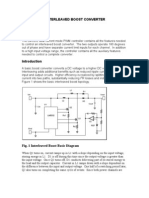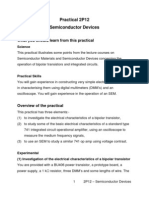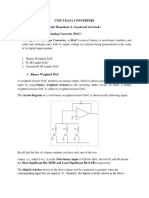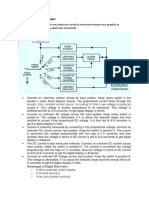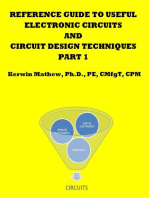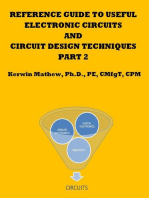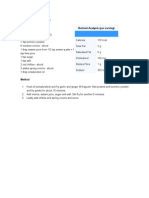Department of Electronics & Telecommunication
Department of Electronics & Telecommunication
Uploaded by
MahadevCopyright:
Available Formats
Department of Electronics & Telecommunication
Department of Electronics & Telecommunication
Uploaded by
MahadevOriginal Description:
Original Title
Copyright
Available Formats
Share this document
Did you find this document useful?
Is this content inappropriate?
Copyright:
Available Formats
Department of Electronics & Telecommunication
Department of Electronics & Telecommunication
Uploaded by
MahadevCopyright:
Available Formats
PUNE INSTITUTE OF COMPUTER TECHNOLOGY, PUNE - 411043
Department of Electronics & Telecommunication
CLASS:
S.E. E &TC
SUBJECT: EIT
EXPT. NO. : 2
DATE:
TITLE
: DIGITAL MULTIMETER
OBJECTIVE
1. AC Voltage Measurement: Line-Neutral, Line-Earthing, Earthing-Neutral
2. DC Voltage Measurement: Vary the DC Power Supply
DC Current Measurement: LED Current Measurement.
3. AC Current Measurement: Using Variable Dimmerstat.
4. All types of resistors (MFR, CFR, Variable and Fixed) to be tested &
measured
5. Color code Measurement of resistor and wattage measurement on DMM.
To explain Resolution concept of DMM, measurement on 3, 4 and 6
digit DMM.
6. Measurement and comparison of hfe BJT BC547/BC548
Testing of BJT, Diodes, FET: Forward / Reverse Biased, faulty conditions,
Open and Short Circuit conditions.
APPARATUS
: 1.
2.
3.
4.
THEORY
:
1.
2.
3.
4.
Digital multimeter with probes
Sample resistor, capacitor, LED, Transistor
Signal generator
CRO with probes
Advantage and features of DMM
DMMS have improved the accuracy, stability and versatility
of older analog meters.
Low cost, portable and easier to use than analog meters.
Auto ranging facility Some of the DMMs select the correct
range for displaying the measured with maximum number
of significant digits.
Auto-polarity selection: It enables the instrument to read
either polarity of voltage or current or display the polarity.
P:F:-LTL-UG/03/R1
2.1
EIT
PUNE INSTITUTE OF COMPUTER TECHNOLOGY, PUNE - 411043
Department of Electronics & Telecommunication
5. Overload protection: Protection against the excessive
measured.
6. Peak hold: To measure and hold the peak value of the
signal.
7. Logic sensing: To check logic 0 and logic1 levels in the
digital logic circuits.
8. For industrial applications ruggedized meters are also
designed for protection against sprayed water heat or
accidental overload.
BLOCK DIAGRAM OF DMM:
Display
Ac
attenuator
and
converter
ac
dc
High
Dc
Attenuator
A/D
Converter
Optional
IEEE-488
output
Ohms
Amps
Ohms
Converter
Control
logic and
precision
reference
Optional
BCD
Output
Shunts
BRIEF DESCRIPTION OF BLOCK DIAGRAM:
DC Voltage attenuator:
P:F:-LTL-UG/03/R1
2.2
EIT
PUNE INSTITUTE OF COMPUTER TECHNOLOGY, PUNE - 411043
Department of Electronics & Telecommunication
The DC signals that can be handled by the input of an A/D
converter are in general limited to less than 10V. This means that
DC voltages of more than 10V have to be attenuated in the input
stage of a DMM before they can be passed on to the ADC.
The circuit shows a simple form of attenuator.
1K
200mV
Vin
To ADC
2V
9M
20V
900K
200V
90K
2000V
10K
In 200mV and 2V settings the input signal is directly applied
to the ADC. In the other settings it is attenuated first. The
attenuator offers a fixed input impedance of 10M in all the
settings.
Current to voltage converter:
DC currents are converted into voltages by shunt in way that
the voltage across the shunt at full range is some for all the current
ranges.
The following circuit shows a current to voltage converter .
Overload protection is provided in lower current ranges by
connecting two diodes in anti parallel. In case of overloads one of
the diode starts conducting and the fuse blows off.
P:F:-LTL-UG/03/R1
2.3
EIT
PUNE INSTITUTE OF COMPUTER TECHNOLOGY, PUNE - 411043
Department of Electronics & Telecommunication
Iin
200uA
900
2mA
90
20mA
To ADC
9
200mA
0.9
2A
0.1
Fuse
0
AC / DC converter:
A widely used system for AC/DC conversion is average
detector as shown in below
R2
D1
i2
R3
Vin
D2
Vd
R1
R1
OP-AMP
In average detector it can be shown that
Thus Vd is linear function of Vin(ac)
P:F:-LTL-UG/03/R1
2.4
R2
R1
Vd Vin
EIT
PUNE INSTITUTE OF COMPUTER TECHNOLOGY, PUNE - 411043
Department of Electronics & Telecommunication
Resistance to voltage converter:
Resistances are measured by passing a constant current
through unknown resistance Rx and then measuring voltage across
it. A possible circuit is shown below.
Constant
current
generator
R2
R1
DC o/p
Rx
RL
In this case the input voltage to the OP-AMP is constant, while
the output voltage is Rx(Vin/R1), that is proportional to Rx.
Analog to digital converter (ADC):
The function of ADC is to convert the analog input signal into
discrete number of steps that can easily be counted and presented
in decimal form on a numerical display. A/D conversion can be
divided into two process like sampling and quantization as shown
below.
Analog
Input
Sampler
Quantizer
Digital
output
The process of converting the sampled analog quantity to
digital number is quantization.
RMS and TRUE RMS measurement:
Most DMMs rectify ac and measure the average of the rectified
ac waveform. The value is converted in rms value for display by
scaling the result by a factor of 1.11 (ratio of rms to average for
sine waveform). This is referred as an RMS measurement. If the
P:F:-LTL-UG/03/R1
2.5
EIT
PUNE INSTITUTE OF COMPUTER TECHNOLOGY, PUNE - 411043
Department of Electronics & Telecommunication
input signal contains a dc component or if the input signal is nonsinusoidal waveform, the results of RMS measurement are
inaccurate.
Some new DMMs incorporate true RMS reading feature. This is
achieved by having an circuit which does have true rms to dc
conversion like IC AD736(True rms to dc converter).
Bandwidth of the meter:
The ac voltage measurements are inaccurate if the input
signal frequency is not within the limits of bandwidth of the meter.
Typically the lower frequency of the meter is 45Hz and the upper
frequency limit depends upon the meter design (from less than 1
KHz to 1MHz).
Hence it is important to check the specification before
attempting any ac measurements.
Composite voltage measurement:
When a signal comprising of AC and DC components as shown
in the following figure is measured with multimeter, the meter reads
only the dc portion only in the dc voltage range and it measures the
AC portion (RMS value) in the AC voltage range.
AC waveform
DC level
For eg. If sine wave off 10 Vp-p with +5V dc shift is measured with
the multimeter, it will show following readings
DC voltage range:
5.0V
AC voltage range:
3.535V
10VP P
2 2
DIGITAL MULTIMETER SPECIFICATION:
Resolution:
Resolution can be expressed by the number of digits,
which can be displayed or it can be expressed as the smallest
P:F:-LTL-UG/03/R1
2.6
EIT
PUNE INSTITUTE OF COMPUTER TECHNOLOGY, PUNE - 411043
Department of Electronics & Telecommunication
difference in voltage, current or resistance that the meter can
display.
The number of digits shown on the DMM is expressed as
mixed number as 3 or 3 or 5 etc. The whole number
indicates the number of nines the display is able to show. The
fraction indicates the display is unable to show all possible
decimal numbers in most significant position. For eg. The
fraction indicates that MSD can be either 0 or 1, a
indicates the MSD can either be 0,1 or 3. A 3 display can
show the number from 000 to 3999 or 1 part in 4000 or .
025%.
Resolution of DMM depends upon the resolution of A/D
converter used within it.
Accuracy:
Accuracy is specified as a percentage of the reading plus
or minimum a number of counts to reflect the behavior of the
circuit. Accuracy is also specified as percentage of the reading
plus a percentage of the full scale reading. Accuracy
specification depends upon the type of measurement as well
as the range of measurement.
Sensitivity:
It is the ratio of output response to the input cause
under static condition. It is related to the lowest range
available for a given function. It can be expressed as division
per volt or millimeter per volt.
Response Time:
It is the time required for the meter to respond to an
input signal change. It is dependent on A/D conversion time
and setting time. For automatic measurement, it is an
indication of how many readings can be taken per second
(measurement rate).
Fuses and batteries used in DMM:
Large current surges from overloads or short circuits can lead
to component destruction or electric shocks in DMM. To guard the
P:F:-LTL-UG/03/R1
2.7
EIT
PUNE INSTITUTE OF COMPUTER TECHNOLOGY, PUNE - 411043
Department of Electronics & Telecommunication
DMM a fuse is used. In DMM the fuse used is a glass encapsulated
fuse within which a length of fine wire or thin metal is fitted. It is
heated up and melts if its maximum current rating is exceeded.
This maximum current rating is written on the fuse.
FUSE can be tested on the multimeter by checking the
continuity between the metal end contacts.
Metals end
Contacts
Special alloy wire element
Glass envelope
Battery:
All circuits and electrical equipment require sources of electric
power. The battery is most common sources of the dc power. It
utilizes energy from electromechanical reaction to supply this
power.
The battery used in DMM is generally a high-power zinc
carbon battery of 9 volts. Zinc carbon batteries are commonly
used because of their low cost and general application capability.
The quantity termed as capacity of a battery indicates the number
of ampere-hours (A-h). A battery can deliver before terminal
voltage drops below certain designated level. Manufacture some
times specify the shelf life (maximum life) of battery which is
defined as the period of time required to reduce the battery
voltage to around 90% of its original value if it is not used.
Observation Table:
AC Voltage Measurement
Line-Neutral
Line-Earth
Earth-Neutral
Observed
Standard
DC Voltage Measurement
Observed
Theoretical
Experimental set up for AC Current Measurement:
P:F:-LTL-UG/03/R1
2.8
EIT
PUNE INSTITUTE OF COMPUTER TECHNOLOGY, PUNE - 411043
Department of Electronics & Telecommunication
Using Variable Dimmer stat
Experimental set up for DC Current Measurement:
LED Current Measurement
Resistor Measurement
Type of the
Resistor
Value Observed by
Color Code
Measurement Using
DMM
Transistor Measurement Diagram:
P:F:-LTL-UG/03/R1
2.9
EIT
PUNE INSTITUTE OF COMPUTER TECHNOLOGY, PUNE - 411043
Department of Electronics & Telecommunication
component measurement
Forward
Voltage
Reverse
Voltage
Open
Condition
Close
Condition
Transistor
BC547
BE
BC
CE
hfe
BC548
BE
BC
CE
hfe
SL100
BE
BC
P:F:-LTL-UG/03/R1
2.10
EIT
PUNE INSTITUTE OF COMPUTER TECHNOLOGY, PUNE - 411043
Department of Electronics & Telecommunication
CE
hfe
BE
BC
CE
hfe
BE
BC
CE
hfe
SK100
2N3055
Diode
1N4007
1N4148
References:
1. Helfrick
and Cooper, Modern
Measurement. Tata Mcgraw Hill
2. DMM Instruction Manual
3. http://www.epanorama.net/links
Electronic
Instrumentation
and
QUESTION: DIGITAL MULTIMETER
1. What is the percent resolution of
a. A 10 bit A/D converter
b. A 15 bit A/D converter
2. What is the resolution in volts for the following meters?
a. 3 digit meter on 2V range
b. 3 digit meter on 20V range
c. 4 digit meter on 20V range
3. Can a 2 digit meter measure 1mV if the basic range is 0
to 200V
4. If 2 DMMs have following specification, compute the
possible error for given specifications for a 3 digit meter
operating at 250C with input of 100V.
P:F:-LTL-UG/03/R1
2.11
EIT
PUNE INSTITUTE OF COMPUTER TECHNOLOGY, PUNE - 411043
Department of Electronics & Telecommunication
5.
6.
7.
8.
Meter 1:- Accuracy 0.05 % rdg (reading) +1 digit
at 250C
Meter 2:- Accuracy 0.05 % rdg (reading) +0.03%
FS (full scale) at 250C
For the multimeter you are using write
a. Battery voltage
b. Fuse rating
What is the use of logic on the DMM?
What is the input impedance of the DMM you are using,
while doing the voltage measurements?
What will be the expected readings if following waveforms
are measured in
a. AC range
b. DC range of DMM
i. Half wave rectified output with 15Vp amplitude.
ii. Half wave rectified output with 15Vp amplitude.
iii. Sine wave with Vp=10V and a DC of 5V.
P:F:-LTL-UG/03/R1
2.12
EIT
You might also like
- Home Appliances Repair 800hrsDocument21 pagesHome Appliances Repair 800hrsMahadev0% (2)
- Human Anatomy DiagramsDocument177 pagesHuman Anatomy DiagramsZoltánné FarkasNo ratings yet
- 11.4 Meiosis: Multiple ChoiceDocument5 pages11.4 Meiosis: Multiple ChoiceMING ZHUNo ratings yet
- Digital Multimeters - Basics of Structure and OperationDocument13 pagesDigital Multimeters - Basics of Structure and Operationsardornozimov2000No ratings yet
- Unit 4 Bxe NoteDocument17 pagesUnit 4 Bxe NotesameerNo ratings yet
- Instrumentation AmplifierDocument3 pagesInstrumentation AmplifierFreddy LlusionNo ratings yet
- Presentation - On-Chip Current Sensing Technique For Cmos Monolithic Switch-ModeDocument30 pagesPresentation - On-Chip Current Sensing Technique For Cmos Monolithic Switch-Modesohailasghar_tNo ratings yet
- Print ElectricalDocument13 pagesPrint ElectricalLiaquat AliNo ratings yet
- Me170a - Lab 01 - Instrumentation Handout - Edited2015Document8 pagesMe170a - Lab 01 - Instrumentation Handout - Edited2015andman753No ratings yet
- Making Accurate DC Voltage Measurements in The Presence of Series Mode AC SignalsDocument6 pagesMaking Accurate DC Voltage Measurements in The Presence of Series Mode AC SignalsRangga Kusuma NegaraNo ratings yet
- Lab Manual Electronics EngineeringDocument67 pagesLab Manual Electronics EngineeringMuhammad Anas ToheedNo ratings yet
- Digital Measurement of Electrical QuantitiesDocument8 pagesDigital Measurement of Electrical QuantitiesMs. Bhavini KumawatNo ratings yet
- Basics of Electrical EngineeringDocument100 pagesBasics of Electrical Engineeringdeep voraNo ratings yet
- Using Digital Potentiometers in Adjustable Step-Down DC-DC Converter DesignsDocument9 pagesUsing Digital Potentiometers in Adjustable Step-Down DC-DC Converter Designsmelwyn_thomasNo ratings yet
- Adi Design SolutionDocument7 pagesAdi Design SolutionMark John Servado AgsalogNo ratings yet
- Measuring The Impedance of Ultrasonic Transducers: Waldemar Lis, Jan SchmidtDocument6 pagesMeasuring The Impedance of Ultrasonic Transducers: Waldemar Lis, Jan SchmidtHarwi HarwiNo ratings yet
- Digital VoltmeterDocument17 pagesDigital VoltmeterVincent KorieNo ratings yet
- Digital Voltmeter, Qmeter, Smith ChartDocument11 pagesDigital Voltmeter, Qmeter, Smith ChartAnil AgarwalNo ratings yet
- Coil Craft - Selecting InductorsDocument5 pagesCoil Craft - Selecting InductorsklangrobNo ratings yet
- Lm5032 Interleaved Boost Converter: D1 L1 Vin VoutDocument12 pagesLm5032 Interleaved Boost Converter: D1 L1 Vin VoutParvesh GautamNo ratings yet
- ANALOG AND DIGITAL IC Short Question With AnswerDocument46 pagesANALOG AND DIGITAL IC Short Question With AnswerMATHANKUMAR.S100% (2)
- Digital Digital Meters MetersDocument30 pagesDigital Digital Meters MetersAbhinav GuptaNo ratings yet
- CN0217Document6 pagesCN0217alraca1234No ratings yet
- Bxe Unit 4Document12 pagesBxe Unit 4aryaagharkar7100% (1)
- Analog and Digital Ic'S Short Questions With AnswersDocument41 pagesAnalog and Digital Ic'S Short Questions With Answerspriya adhavanNo ratings yet
- Unit Iv Adc & Dac 2 MarksDocument5 pagesUnit Iv Adc & Dac 2 MarkssasirekhaNo ratings yet
- Using A BJT As A Switch: An Example: BelowDocument10 pagesUsing A BJT As A Switch: An Example: BelowPrakhar BhatnagarNo ratings yet
- Is Electrical Interference Crippling Your Control System? Understand It and You Can Defeat ItDocument5 pagesIs Electrical Interference Crippling Your Control System? Understand It and You Can Defeat ItHayden LovettNo ratings yet
- Dehn VFD App Note Chapter - 09 - 01Document3 pagesDehn VFD App Note Chapter - 09 - 01Frank BascianoNo ratings yet
- Project 2 ElectronicDocument23 pagesProject 2 ElectronicOmar Eduardo Rios GuzmanNo ratings yet
- 8 Hints For Successful Impedance MeasuremDocument12 pages8 Hints For Successful Impedance MeasuremJesús MartínezNo ratings yet
- High Accuracy Impedance Measurements Using 12-Bit Impedance ConvertersDocument6 pagesHigh Accuracy Impedance Measurements Using 12-Bit Impedance Converterschristobal_huntaNo ratings yet
- Reference Design Low Cost CompassDocument4 pagesReference Design Low Cost CompassHany MaximousNo ratings yet
- Prepaid Energy MeterDocument38 pagesPrepaid Energy MeterPriyanka KalburgiNo ratings yet
- Epl Electronics Lab ManualDocument40 pagesEpl Electronics Lab ManualSivarama Krishnan SNo ratings yet
- Practical 2P12 Semiconductor Devices: What You Should Learn From This PracticalDocument11 pagesPractical 2P12 Semiconductor Devices: What You Should Learn From This PracticalDevesh GargNo ratings yet
- Emt 2422 L3Document29 pagesEmt 2422 L3Fred MuthokaNo ratings yet
- DAC AnalysisDocument19 pagesDAC Analysisమురళీధర్ ఆది ఆంధ్రుడుNo ratings yet
- Snubber Circuit Design CalculatorsDocument3 pagesSnubber Circuit Design CalculatorsteomondoNo ratings yet
- Acc Measure Nanoamperes AppNotesDocument3 pagesAcc Measure Nanoamperes AppNotesRabshaqaNo ratings yet
- Exp_2Document7 pagesExp_2Saim HaqNo ratings yet
- Lab Report Temperature TransmitterDocument12 pagesLab Report Temperature Transmitterathira sNo ratings yet
- PAPER EI (2) by Pankaj SirDocument247 pagesPAPER EI (2) by Pankaj SirMahesh SinghNo ratings yet
- Capacimetre FemtoDocument30 pagesCapacimetre FemtoJean-Marie ChaputNo ratings yet
- Power Failure AlarmDocument17 pagesPower Failure AlarmPurva Patil33% (3)
- Buck Converter Design DemystifiedDocument6 pagesBuck Converter Design DemystifiedEric MorissetNo ratings yet
- Unit-5 ADCDocument8 pagesUnit-5 ADCDr. M Kiran KumarNo ratings yet
- Optimizing The Design of A Switched-Capacitor Dynamic-Element-Matching AmplifierDocument6 pagesOptimizing The Design of A Switched-Capacitor Dynamic-Element-Matching Amplifierreza12368No ratings yet
- AnalogDocument16 pagesAnalogchandushar1604No ratings yet
- Sumber MateriDocument12 pagesSumber MateriRedy TazwaNo ratings yet
- EMI Conducted InterferenceDocument12 pagesEMI Conducted Interferencee175470_rmqkr_netNo ratings yet
- Unit 4 NotesDocument9 pagesUnit 4 NotesPrathamesh BhavsarNo ratings yet
- An 477Document28 pagesAn 477radaresNo ratings yet
- Precision Power Analyzer: 1 To 8 Channels DC - 10 MHZ Accuracy 0.025 %Document12 pagesPrecision Power Analyzer: 1 To 8 Channels DC - 10 MHZ Accuracy 0.025 %tsampouriseNo ratings yet
- Es1107 Assignment-01Document6 pagesEs1107 Assignment-01K. BHANU PRAKASH REDDYNo ratings yet
- LIC Question BankDocument7 pagesLIC Question BankParvathy S ParvathyNo ratings yet
- Digital Stop WatchDocument54 pagesDigital Stop WatchAshishNo ratings yet
- Wyatt Na Ddg12Document6 pagesWyatt Na Ddg12Antonio BergnoliNo ratings yet
- Ancrct 4 ImpDocument1 pageAncrct 4 Impramesh_br85100% (1)
- Reference Guide To Useful Electronic Circuits And Circuit Design Techniques - Part 1From EverandReference Guide To Useful Electronic Circuits And Circuit Design Techniques - Part 1Rating: 2.5 out of 5 stars2.5/5 (3)
- Reference Guide To Useful Electronic Circuits And Circuit Design Techniques - Part 2From EverandReference Guide To Useful Electronic Circuits And Circuit Design Techniques - Part 2No ratings yet
- STEM: Science, Technology, Engineering and Maths Principles Teachers Pack V10From EverandSTEM: Science, Technology, Engineering and Maths Principles Teachers Pack V10No ratings yet
- Fdn342P: P-Channel 2.5V Specified Powertrench MosfetDocument5 pagesFdn342P: P-Channel 2.5V Specified Powertrench MosfetMahadevNo ratings yet
- JUNE 2012: Amiete - Et (New Scheme)Document3 pagesJUNE 2012: Amiete - Et (New Scheme)MahadevNo ratings yet
- JUNE 2013: Code: AE74 Subject: VLSI DESIGNDocument3 pagesJUNE 2013: Code: AE74 Subject: VLSI DESIGNMahadevNo ratings yet
- Wall Mounting: A Solution To LCD/LED TV Viewing Angle IssuesDocument4 pagesWall Mounting: A Solution To LCD/LED TV Viewing Angle IssuesMahadevNo ratings yet
- Ae68 4Document3 pagesAe68 4MahadevNo ratings yet
- Ae56 D10Document4 pagesAe56 D10MahadevNo ratings yet
- Practical Electronic Circuits For AutomotiveDocument7 pagesPractical Electronic Circuits For AutomotiveMahadev0% (1)
- Features Description: 4-Digit LED Display, Programmable Up/Down CounterDocument20 pagesFeatures Description: 4-Digit LED Display, Programmable Up/Down CounterMahadevNo ratings yet
- Flange DeflectionDocument4 pagesFlange Deflectiondroessaert_stijnNo ratings yet
- The Adventures of Sharkboy and Lavagirl in 3-D (2005)Document87 pagesThe Adventures of Sharkboy and Lavagirl in 3-D (2005)Bayu Sembuluh SimpaNo ratings yet
- Impact Level1 Unit 2wbDocument12 pagesImpact Level1 Unit 2wbVẫn Huỳnh ThịNo ratings yet
- Bread Faults and Their Causes - 031916Document4 pagesBread Faults and Their Causes - 031916Elizabeth NocilladoNo ratings yet
- Solved Problems PDFDocument11 pagesSolved Problems PDFErmias Mergia100% (5)
- Correction To ISO Reference Ambient Conditions Plate 70624-40DDocument1 pageCorrection To ISO Reference Ambient Conditions Plate 70624-40DMax MaksNo ratings yet
- North Perimeter Highway Public Engagement PresentationDocument22 pagesNorth Perimeter Highway Public Engagement PresentationChrisDcaNo ratings yet
- Service Marketing Chapter-01Document24 pagesService Marketing Chapter-01Ayyaz ReshiNo ratings yet
- Safety Data Sheet: Section 1. IdentificationDocument8 pagesSafety Data Sheet: Section 1. IdentificationRajaIshfaqHussainNo ratings yet
- Instant NoodlesDocument11 pagesInstant NoodlesBryan LeeNo ratings yet
- SPL Led 960b User ManualDocument7 pagesSPL Led 960b User ManualElectric GuardNo ratings yet
- CH402E - Spot Welding QualityDocument16 pagesCH402E - Spot Welding Qualitylinh caca huynhNo ratings yet
- All Institute-Branch Combinations (Jexpo)Document8 pagesAll Institute-Branch Combinations (Jexpo)PraNay MonDalNo ratings yet
- Dose Ordered Dose Available X Volume Available: O Calculate Rate Using MinutesDocument27 pagesDose Ordered Dose Available X Volume Available: O Calculate Rate Using Minutesmaryhiromi10No ratings yet
- Udang Goreng ManisDocument1 pageUdang Goreng Manisapi-3711299No ratings yet
- Textbook Critical Anthropological Engagements in Human Alterity and Difference 1St Edition Bjorn Enge Bertelsen Ebook All Chapter PDFDocument51 pagesTextbook Critical Anthropological Engagements in Human Alterity and Difference 1St Edition Bjorn Enge Bertelsen Ebook All Chapter PDFandrew.morrison794100% (19)
- Seismic Evaluation and Retrofit of Ghaflankouh Historical Railway Masonry Arch BridgeDocument11 pagesSeismic Evaluation and Retrofit of Ghaflankouh Historical Railway Masonry Arch Bridgemohammad safiNo ratings yet
- Vocabulary (Past Papers)Document4 pagesVocabulary (Past Papers)BiYa ɱɥğȟålNo ratings yet
- Science, Tenchnology, and Nation-Building: Study Guide For Module No. 4Document16 pagesScience, Tenchnology, and Nation-Building: Study Guide For Module No. 4anneNo ratings yet
- Ascites PDFDocument8 pagesAscites PDFJanina Patricia BuddleNo ratings yet
- Basics Instrument and ControlDocument222 pagesBasics Instrument and ControlSamuel Onyewuenyi100% (2)
- Product Sheet June 2004: Rubber ProfileDocument1 pageProduct Sheet June 2004: Rubber ProfileEnrico ManfrinatoNo ratings yet
- Kecamatan Tanah Siang Dalam Angka 2022Document174 pagesKecamatan Tanah Siang Dalam Angka 2022BAGREN RESMURANo ratings yet
- Liver HealthDocument9 pagesLiver HealthperdidalmaNo ratings yet
- LaptopDocument22 pagesLaptopKrishna PhNo ratings yet
- Slub Yarn TechnologyDocument5 pagesSlub Yarn TechnologysubhashNo ratings yet
- CS8092 CGM QB A4Document34 pagesCS8092 CGM QB A4SharmilaNo ratings yet
- Catálogo General Snap-OnDocument1,336 pagesCatálogo General Snap-OnEfrain AvilaNo ratings yet



















